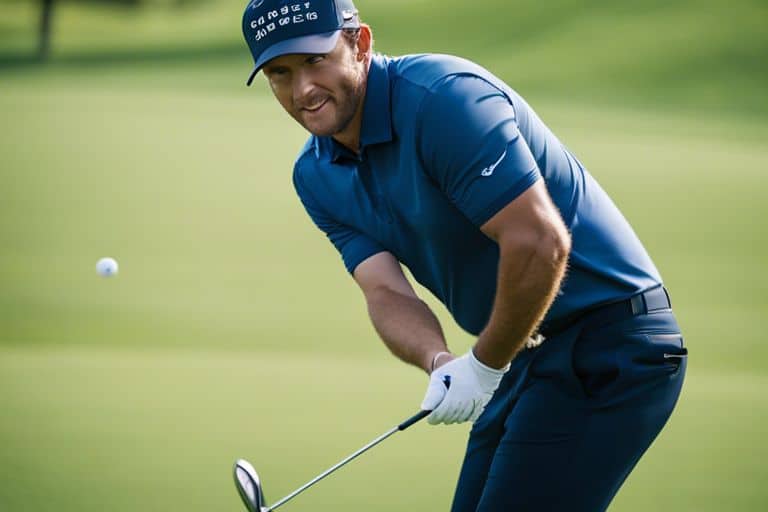What does it mean to "duck hook and roll" a shot in golf?
As an avid golfer, I have come to understand the significance of mastering different shot techniques. One of the most challenging shots to execute is the “duck hook and roll,” which can either make or break your game. When you “duck hook and roll” a shot in golf, you are hitting the ball with a severe hook, causing it to curve sharply to the left (for right-handed golfers). This type of shot can be incredibly dangerous if not executed properly, as it can easily veer into hazards or out-of-bounds areas. However, when done correctly, it can help you navigate around obstacles and position the ball favorably for your next shot.
Analyzing the Duck Hook
For those who are unfamiliar with the term, a duck hook is a shot that curves sharply to the left for a right-handed golfer (and to the right for a left-handed golfer). It is a frustrating and potentially damaging shot that can ruin your scorecard and your confidence. Analyzing the duck hook can help you understand the causes and how to fix it.
Causes of a Duck Hook
One of the most common causes of a duck hook is an overly aggressive inside-out swing path combined with a closed clubface at impact. This produces a shot that initially starts straight or slightly to the right, but then curves violently to the left. Another cause can be an overactive lower body, causing the club to get stuck behind you and leading to an inside-out swing path. Poor grip and setup can also contribute to the causes of a duck hook.
How to Identify a Duck Hook in Your Swing
To identify a duck hook in your swing, pay attention to the flight of your ball. A duck hook will start off on line with your target, but then suddenly veer off to the left (for a right-handed golfer). You may also notice a low, piercing ball flight that doesn’t have much spin. If you consistently see these ball flight patterns, it’s likely that you are duck hooking your shots.

The Mechanics of a Roll Shot
Obviously, to execute a successful roll shot in golf, it is important to understand the mechanics behind it. The roll shot is a crucial skill that can greatly improve your game, especially when faced with challenging course conditions. In this chapter, I will break down the mechanics of a roll shot and provide key insights on how to master this technique.
What is a Roll in Golf?
When we talk about a roll in golf, we are referring to the movement of the golf ball along the ground after it has made contact with the turf. This type of shot is essential when you need to navigate around hazards or when you want to control the distance and direction of your shot with precision. The ability to execute a roll effectively can make a significant difference in your overall performance on the course.
Techniques to Achieve an Effective Roll
One of the most important aspects of achieving an effective roll in golf is the impact position at the moment of contact between the clubface and the ball. When executing a roll shot, you want to ensure that you have a slightly open clubface and a forward shaft lean. This will help impart a topspin on the ball, allowing it to roll smoothly along the ground. Additionally, focusing on a smooth and steady follow-through will also contribute to the success of your roll shot. Remember, mastering the technique is essential for controlling the trajectory and distance of your shots on the course.

Combining Duck Hook and Roll
Despite being two different techniques, the duck hook and the roll can be combined to create a powerful and effective shot in golf. This combination can be used in certain situations to maximize distance and accuracy, but it requires precise execution and a good understanding of the mechanics involved.
When to Use This Combination
When faced with a long fairway and a slight dogleg to the left, the combination of a duck hook and roll can be a game-changer. By using the duck hook to initially veer the ball to the left and then incorporating the roll to make it travel straight, you can effectively navigate the course and set yourself up for a favorable approach shot. This combination is also useful in situations where you need to avoid hazards on the right side of the fairway, allowing you to keep the ball in play while gaining valuable yardage.
Executing the Duck Hook and Roll Effectively
Executing the duck hook and roll effectively requires precise club selection, swing technique, and follow-through. It’s important to choose a club that allows you to generate the necessary speed and spin to create the desired ball flight. When setting up for the shot, focus on aligning your body and clubface to the target line, while also accounting for the curvature you intend to impart on the ball. As you swing through the ball, ensure that your hands release properly to promote the duck hook, and then follow through with a smooth, level motion to achieve the roll. The timing and coordination of these movements are crucial to achieving the desired result.
Strategies to Avoid Unintentional Duck Hooks and Rolls
To avoid unintentional duck hooks and rolls in your golf shots, there are several strategies that you can implement to improve your consistency and accuracy. By paying attention to your technique, practicing specific drills, and considering your equipment, you can significantly reduce the chances of your shots veering off course. Here are some key strategies to keep in mind:
Practice Drills for Consistency
Consistency is key in golf, and practicing specific drills can help you develop a more reliable swing. One effective drill is to focus on your grip and stance, ensuring that they are consistent from shot to shot. By maintaining a stable foundation, you can minimize the chances of unintentional hooks and rolls. Additionally, practicing your swing tempo and rhythm can also contribute to more consistent and accurate shots. By refining these fundamental aspects of your game, you can significantly decrease the likelihood of errant shots.
Equipment Considerations
When it comes to avoiding unintentional duck hooks and rolls, the equipment you use can play a significant role. Ensuring that your clubs are properly fitted to your size, build, and swing can make a world of difference in the consistency of your shots. I recommend consulting with a professional club fitter to determine the optimal shaft length, flex, and clubhead design for your individual needs. Additionally, selecting the right golf ball for your swing speed and style can also contribute to more consistent ball flight and accuracy. By paying attention to these equipment considerations, you can mitigate the risk of unintended hooks and rolls.

Conclusion
Conclusively, “duck hook and roll” is a specific type of shot in golf where the ball is hit with a hook spin, causing it to roll along the ground upon landing. This shot is often used in situations where a player needs to get the ball low and make it run out on the fairway or towards the green. It requires precise control and execution to achieve the desired result, and mastering this shot can be a valuable skill to have in your arsenal as a golfer.






